A review on influence factors promoting or inhibiting the transfer of research from universities into start-ups
Abstract
The aim of this paper is to provide an overview of the state of play in the transfer of chemistry research from universities to start-ups and to look at factors that promote or inhibit this process. Therefore, in the first step, important definitions such as innovation, technology transfer, start-up, and key sectors are explained. In the second step, key findings about key industries and the chemical industry are summarized. In the third step, examples of factors that promote and inhibit technology transfer as well as studies, their methodologies, and results are presented, described, and classified. In the fourth step, the state of knowledge regarding the technology transfer from scientific research into startups in general and for chemistry research in special is summarized. Finally, hypotheses, deriving from the state of the art are formulated suggesting further research in this field.
1 Introduction
In Germany, about 17,000 students study chemistry every year with about 1,000 professors (Statistisches Bundesamt (Destatis), 2022; Society of German Chemists, 2020). At the same time, only 175 – 249 business foundations are founded in the chemical industry each year (Haubold and Calhanoglu). This means that the growth potential for chemistry, with a share of 0.2 % of start-ups in Germany, is below expectations (Opinion Leaders Network, 2022). This paper provides an overview of the factors promoting or inhibiting the transfer of innovation and technology from university departments to start-ups deriving from chemistry research. First, in total 70 sources were screened and reviewed from which 8 sources were found to be relevant for further analysis in more detail. Second, relevant indicators from all relevant studies were identified, and the number of appearances of said indicators was counted, resulting in a so-called score of importance (SOI) (Aksah et al., 2016). Third, the indicators were sorted by the rank of their SOI providing a list of inhibiting and promoting fac-tors, starting with the highest SOI. Finally, two hypotheses were identified suggesting further research. The terms innovation, technology transfer, start-ups, spin-offs from universities, and key sectors are defined in the next sections.
2 Theoretical background
New start-ups create new jobs (Schlaegel and Koenig, 2014), open up new application possibil-ities and technologies, and provide new incentives and innovations that can lead to changes in market structures (Konrad-Adenauer-Stiftung registered association, 2015).
Innovation originates from Latin meaning renewal or change. Dörr et al. (2014) defined innovation as a process starting from an idea transformed into a product or a service (invention) which has not existed before finally being introduced to a certain market (diffusion) (Wolf et al., 2021). Thus, formula 1 defines the term innovation.
Innovation=idea+invention+diffusion (1)
Technology transfer is defined as the transfer or movement of know-how as a process in which adaptations to local conditions occur within as well as between countries (Kanyak, 1985; Chun, 2007; Chung, 2001). The transfer of knowledge can take place through the dissemination of research knowledge, for example through conferences and scientific publications, the training of a qualified workforce, and the commercialization of knowledge. The latter can take place through patents, the founding of a company, spin-off companies, or through contracts with industry, e.g., through licenses (Bolzano et al., 2021). For the development of innovative products, universities are considered as research centers that provide organizational skills, resources, and knowledge through research and teaching (Arenas and González, 2018).
Universities provide support in the form of entrepreneurial idea development, strategic planning, or university-industry cooperation (uic) (Marzocchi et al., 2019). Others support mechanisms described include Science, Technology and Engi-neering Entrepreneurship Education (STEE) for entrepreneurial education and training, of stu-dents or individuals with engineering, technology and science majors or careers (Fayolle et al., 2021), as well as technology transfer offices (TTOs) for commercialization of research results (Holgerssona and Aaboen, 2019).
Currently, there is no single definition for start-up companies, in general. Therefore, four ex-emplary definitions are given below.
- Wierciński (2016) defines start-ups via the “Lean Startup” method as a temporary organization in search of a repeatable and scalable business model (Ries, 2011; Blank, 2013)
- Peter Thiel, founder of PayPal, chairman of Palantir, defines a start-up as a company with the goal of creating a monopoly in a niche market and only then expand-ing into new markets (Thiel and Masters, 2014).
- the founder of Y Combinator, Paul Graham, defines a start-up as a company de-signed to grow quickly (Graham, 2012).
- the German Forum Startup Chemie defines chemical start-ups as companies that have not yet established themselves as a manufacturing chemical company with a fixed prod-uct portfolio, but which take on typical start-up functions, such as the development of new products and processes or the provision of specialized services for chemical com-panies (Gehrke and Rammer, 2019).
Innovations for the economy can be gained, among other things, through the knowhow and technology transfer of university spin-off (USO) (Joachim Herz Stiftung, 2021). A university spin-off is defined as a new company founded by faculty members based on intellectual proper-ty from their research. This allows university technologies to be disseminated and commercial-ized by academic entrepreneurs. By localizing knowledge, university spinoffs are described as a local phenomenon and thus offer a contribution to industry formation and economic dynamism (Hayter, 2013).
Since research at universities is conducted in a vast variety of subject areas and topics, it can be of interest to assign them to so-called key sectors, such as the technology-, IT- or the chemical sector. Key sectors can be described as the most valuable sectors of an economy (Hewings, 1982). The identification thereof is made under the consideration that economic sectors do not exist in a vacuum but that there are many cross-industry linkages between them. Key sectors are defined as sectors with close interdependencies with other production sectors. These interdependencies can consist of the use of products produced by others and the use of products produced by others (Temurshoev, 2004).
Within the EU countries, the important sectors identified were wholesale trade, construction, food and beverages, real estate, and chemicals. On the technology side, chemicals, electrical energy, natural gas, base metals, and machinery and equipment were identified. For Germany, the most important sectors are motor vehicle trailers and semitrailers, other business services, machinery and equipment, construction, and chemicals (Alatriste-Contreras, 2015). The European Union is the world’s largest producer of chemicals and is also at the forefront of technological development within this sector. This makes the chemical industry a key sector of the European economy and will be described individually below (Eder and Sotoudeh, 2000).
The fact that chemistry is a part of nearly every value chain of all physical products, creates opportunities for chemical entrepreneurship and innovation (Abigail et al., 2022). With this in mind, global challenges such as human health, crop production, energy generation or storage, water supply security, or climate change can only be solved with chemical innovations (Confalone, 2014; Sachse and Martinez, 2016). Within the chemical industry, the need for new innovation approaches and partnerships is described for future innovation projects. The need for redesigned or newly established value chains as an alternative to new chemical substances is pointed out by Landwehr-Zloch and Glaß (2020).
The best-known models for investigating factors influencing the intention and willingness to start a business are the entrepreneurial event model (EEM) (Shapero, 1984) and the theory of planned behaviour (TPB) (Ajzen, 1985). Within the EEM, business start-ups are seen as the result of external changes and triggering events that influence the perception of individuals (Shapero, 1984). The TPB examines attitudes towards behaviour, the subjective norm and per-ceived behavioural control, i.e., key motivational factors that influence intention, which is considered a precursor to the performance of behaviour (Ajzen, 1985).
The motivation for this review article is the interest in the start-up activity from chemistry faculties leading to innovations in the chemical industry. The aim is to get a general understanding of the factors and whether the number of start-ups generated from chemistry faculties is relatively high or low. The facilitating factors are interesting for strategic measures by decision-makers to support and enhance start-up activities. The hindering factors serve as barriers and provide the opportunity for further research to overcome them. Since the literature search resulted in only one specific publication related to chemistry start-ups, the further investigation of promoting or inhibiting factors regarding the technology transfer from universities into start-ups was done with a more general approach.This approach is supported by Landrya et al. (2006) stating the importance of spin-offs from universities in general because of their access to highly specialized resources like expertise and laboratory infrastructure.
3 Methods
For this work, the literature on chemical start-ups and chemical innovation was analyzed, covering a time range from 1982 until 2022 derived from academic journal articles and books (45 sources in total). A search for publications with the keywords “entrepreneurial event model” and “theory of planned behaviour”yielded 1,410 and 125,000 hits respectively. This recognizes the TPB as a better-known research model. The addition of “chemistry students” reduces the number of hits to 79. The evaluation of these papers revealed one study from India (Abigail et al., 2022). Due to the lack of data for the individual factors and the evaluation as a group, there is no evaluation for the influencing factors. Due to a lack of evaluable studies on the influencing factors among chemistry students in particular, the following evaluation of 8 out of 34 surveys was carried out on influencing factors in general, irrespective of the origin, level of education, income, and subject area of the participants, for an initial overview of important influencing factors. Only studies were used which evaluated the factors individually or gave the result of the survey and did not combine them into groups. The selected studies are based on an identical methodology and thus enable a comparison.
Second, relevant indicators from all relevant studies were identified, and the number of appearances of said indicators was counted, resulting in a so-called score of importance (SOI) (Aksah et al., 2016). The objective of the SOI is to classify the different inhibiting and promoting factors for business start-ups from the various publications. To summarize the findings, we analysed the SOI based on the respective rankings within the respective surveys. The most fre-quent factor was rated with 3 points the second with 2 and the third with 1 point. If factors were ranked equally, they were listed twice. The final rating of importance is determined by summing up the individual points. The comparison of the respective total SOIs yields the most important factors from the selected studies. Third, the indicators were sorted by the rank of their SOI providing a list of inhibiting and promoting factors, starting with the highest SOI.
4 Results
General factors
Studies examining entrepreneurial intentions in different countries often focus on three basic factors: culture, business climate, and education. Culture is defined as a set of shared values and beliefs between groups of people (Ajzen, 1991). The study of Engle (2008) examined twelve countries (Bangladesh, China, Costa Rica, Egypt, Finland, France, Germany, Ghana, Russia, Spain, Sweden and the USA) regarding their intentions for entrepreneurial actions in relation to their cultural background. Thereby, the cultural differences were confirmed in terms of attitude towards behaviour, social norms and perceived self-control.
The second factor, differentiates countries in terms of the level of economic development or climate, thus differentiating entrepreneurial intent. The economic environment affects the level and type of entrepreneurial activity, especially when comparing developed and developing countries (Iakovleva et al., 2011). The Global Entrepreneurship Monitor (GEM), was launched in 1997 to study this variability in entrepreneurial activity in a total of 59 countries (Sternberg et al., 2022). The research on entrepreneurial activities in developing and developed countries shows that university students in developing countries are more likely to have entrepreneurial intentions than those in developed countries.
The third factor examined considers entrepreneurial education. Giacomin (2011) asked whether entrepreneurial education should be the same in each country or if there should be an adaptation to the cultural context. Within the survey, entrepreneurial intentions and their relationship with entrepreneurial education were examined among American, Asian, and European students. The results indicate that cultural differences should be taken into account when developing entrepre-neurship education programs.
Factors that promote
Entrepreneurship Education (EE) can be understood as a course or program within a training or study program that encourages entrepreneurs to start a business (Graevenitz et al., 2010). EE within higher education can influence entrepreneurial intentions in two ways. The first way was investigated by Kolvereid (1997), who found that students who took an EE course during their studies had higher entrepreneurial intentions than those who did not. The second possibility was investigated by Franke (2004) referring to the general educational envi-ronment at the university and whether it supported the creation of new businesses. The results show that entrepreneurial intentions correlate with the students’ assessment of the university environment. The article by Abigail (2022) et al. examined the impact of incorporating EE into the undergraduate chemistry curriculum in India. It compared surveys of students with EE in the curriculum with those without. The results indicate a positive effect of EE. At the same time, this survey represents the only one specifically referring to chemistry students (Abigail et al., 2022). Packham et al. (2010) compared the impact of EE on the entrepreneurial attitudes of French, German and Polish students. They found that entrepreneurship education had a positive impact on intentions to start a business in France and Poland, but a negative impact on German students, specifically male students.
The articles analysed and their surveys are based on singlecountry studies such as Malebana (2014) in South Africa, Sandhu et al. ( 2011) in Malaysia, Sarri et al. (2018) and Greece, multi-country comparisons such as Pruett et al. (2009) with USA; China and Spain, Sesen and Pruett (2014) with Turkey and USA or Giacomin et al. (2011) with USA, China, Spain, and Belgium. Another cross-country comparison was made by Kanama (2021) through Japanese data with Giacomin et al. (2011) data. The data can be found in Table 1 with the respective source, country, and number of participants. Table 1 thus serves as a summary of the collected factors that promote entrepreneurial activity.
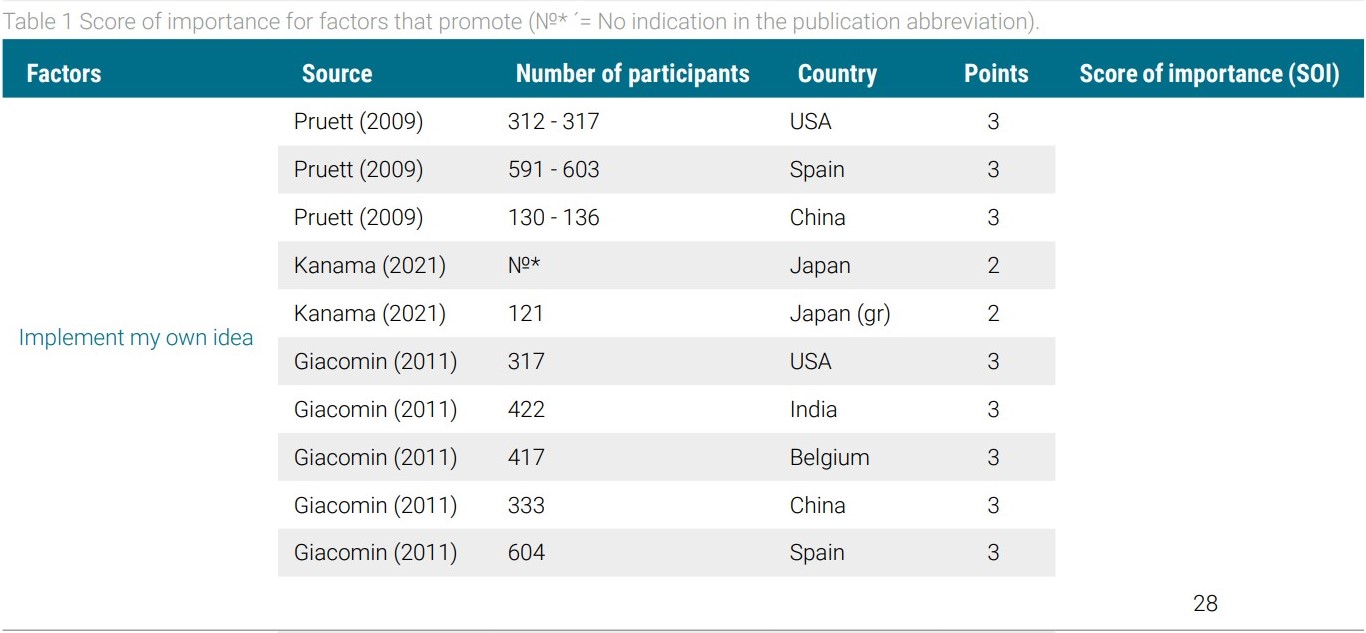
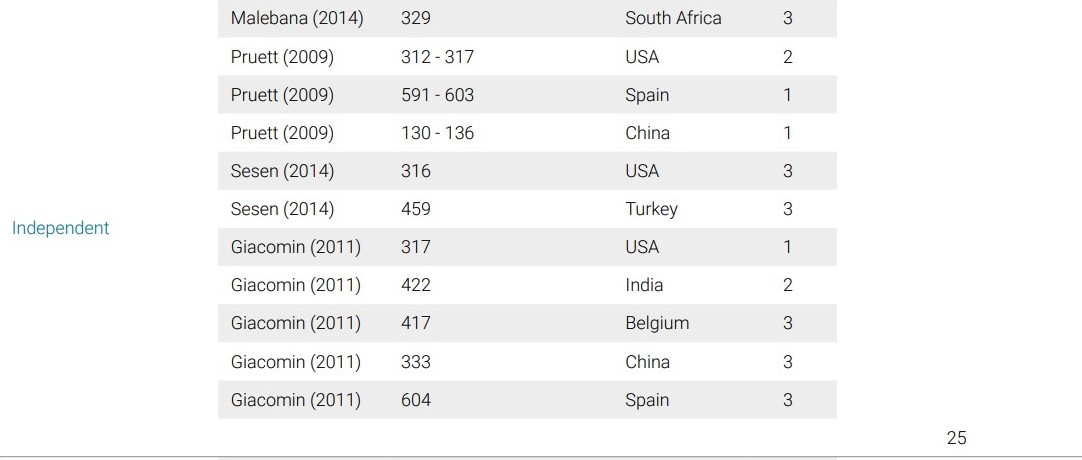
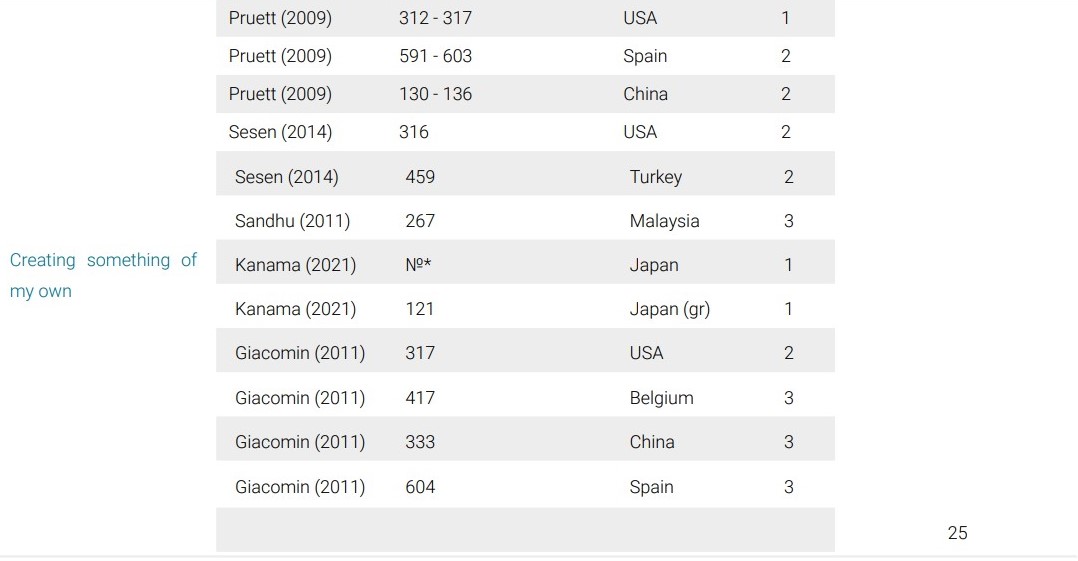
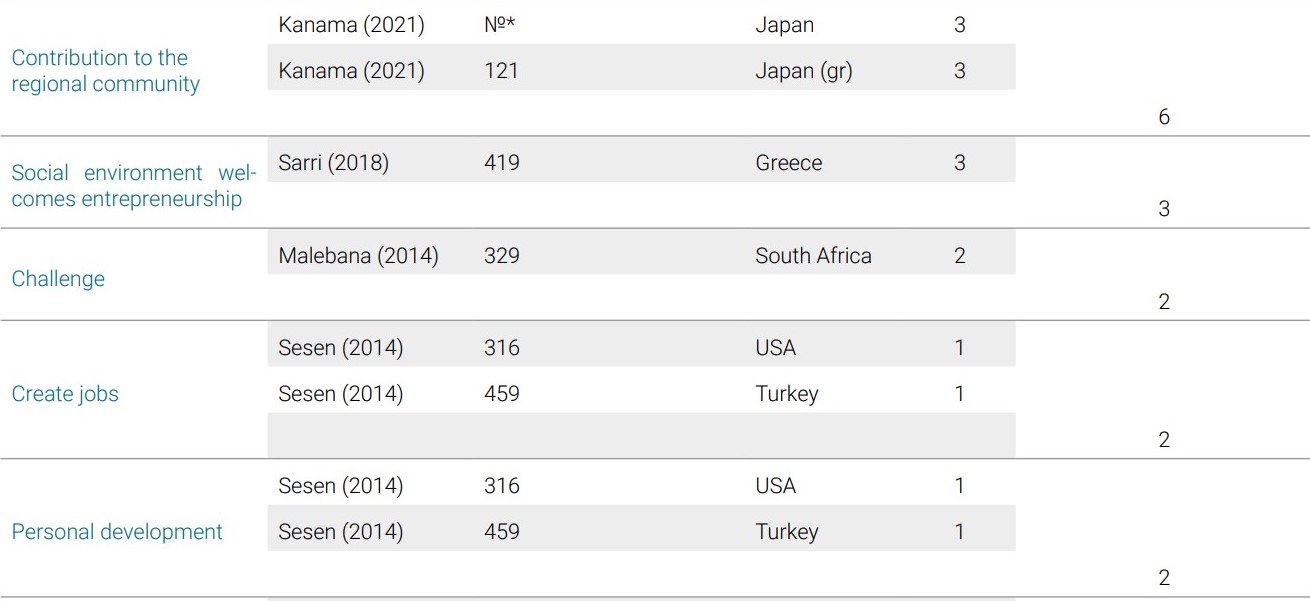
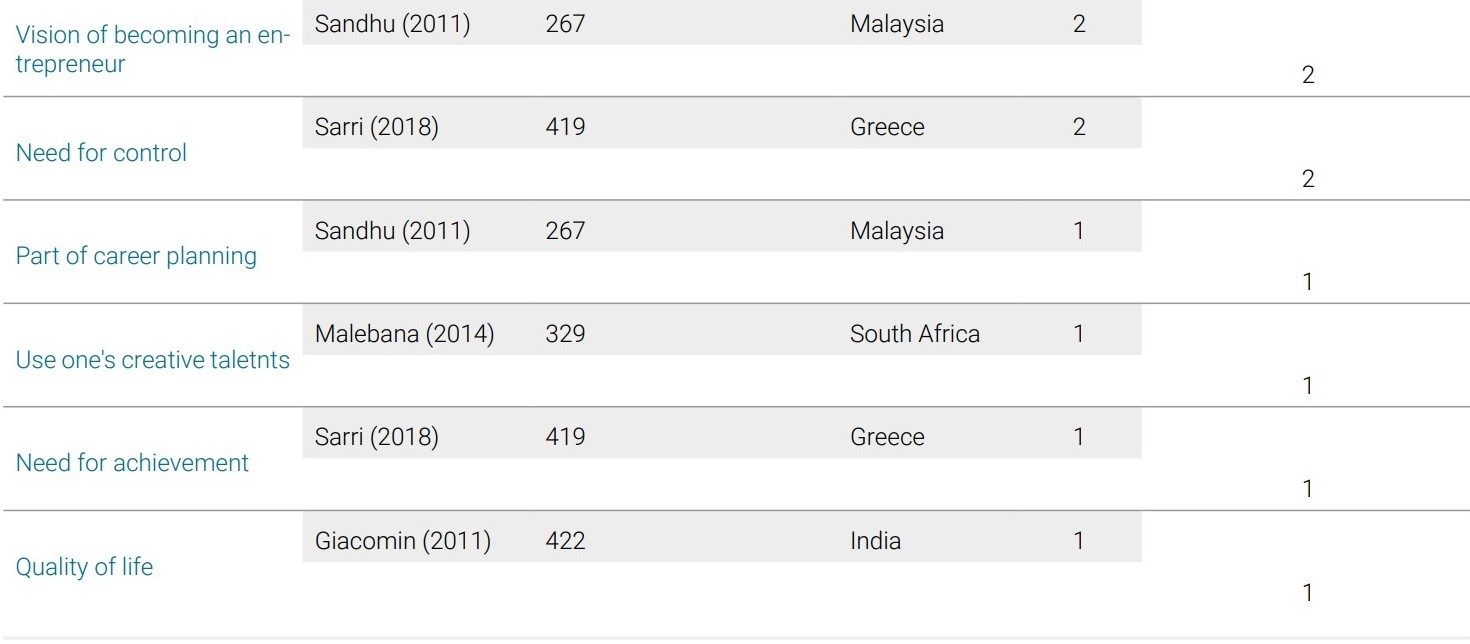
Table 1 shows a clear gradient between the individual factors from the studies. The factors “Implement my own idea”, “Create something of my own” and “Independent” were named most frequently within the surveys analysed. Thus, these factors are the factors that promote entrepreneurial activities the most. The evaluation of variance shows no cultural differences for the factor “Implement my own idea”, in contrast to the factors “Independency” and “Creating something of my own”, which showed a cultural difference in the variance of the SOI. The cultural differences do not allow any conclusion to be drawn about the level of development of the countries, as the rating of “Independency” shows with ratings of one point (Spain, China, USA), two points (USA and India), up to three points (South Africa, USA, Turkey, Belgium, China and Spain). It is interesting to note the different ratings of the countries that were considered in several surveys, such as the USA, Spain, or China. This suggests an influence of the samples surveyed and the respective point in time.
Factors that inhibit
Analogous to the promoting factors, the evaluation of the hindering factors is also carried out. In addition to the articles on the promoting factors, the evaluation of Karimi et al. (2017) with participants and the comparative study of Doanh (2018) with Vietnamese and Polish students will be carried out. The SOI was calculated analogously to the SOI for the promoting factors. Table 2 serves as a summary of the collected factors that promote entrepreneurial activity.
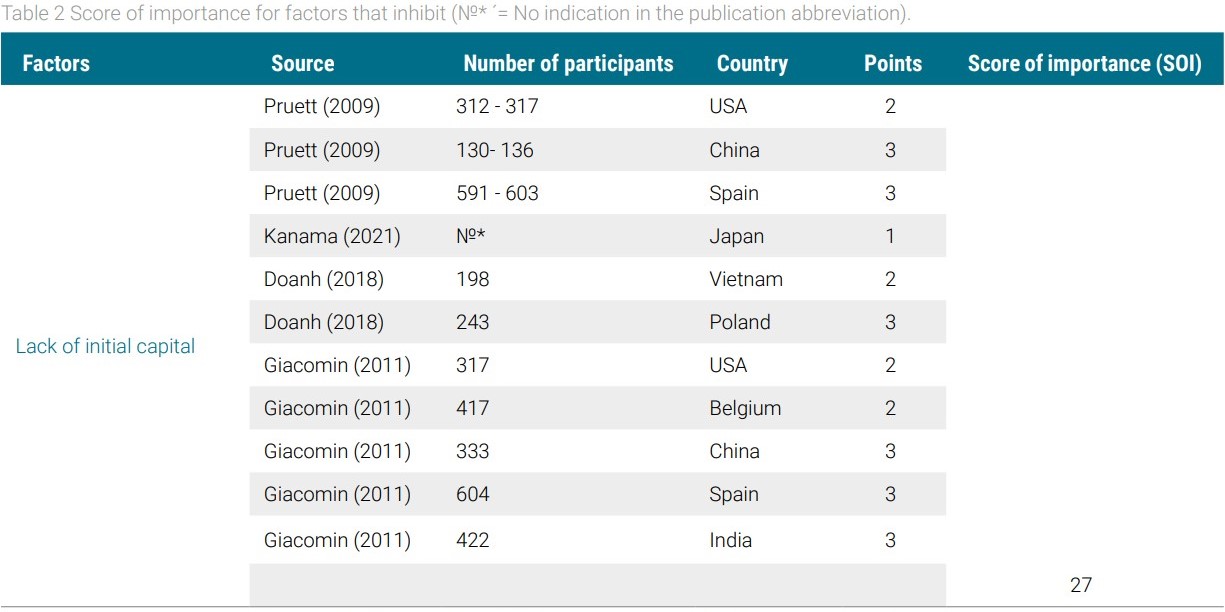
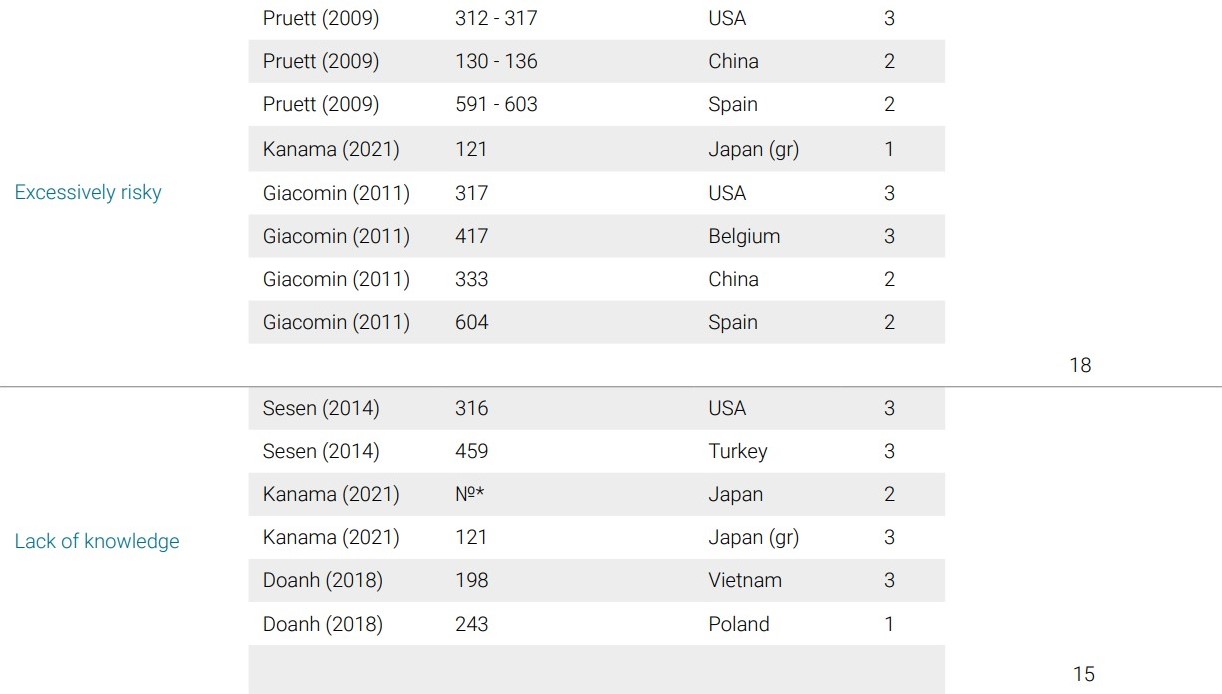
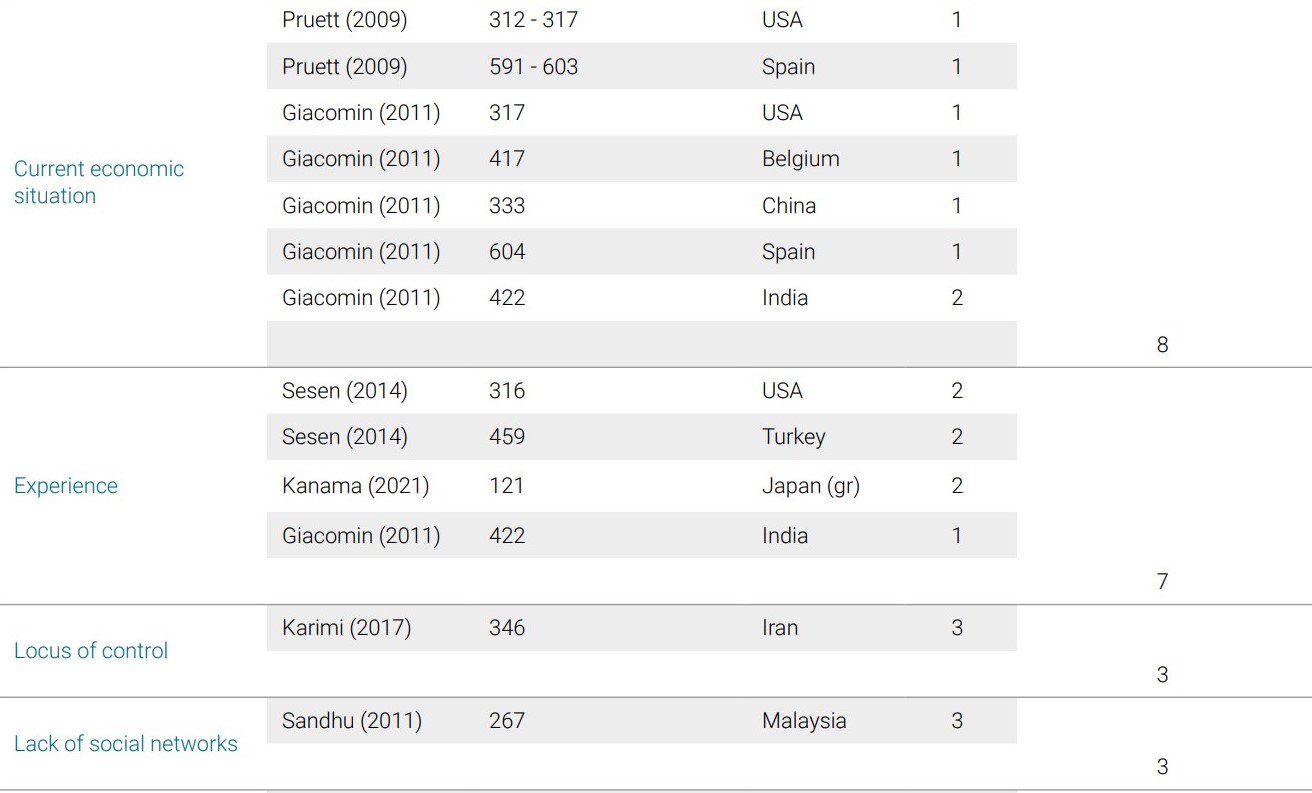
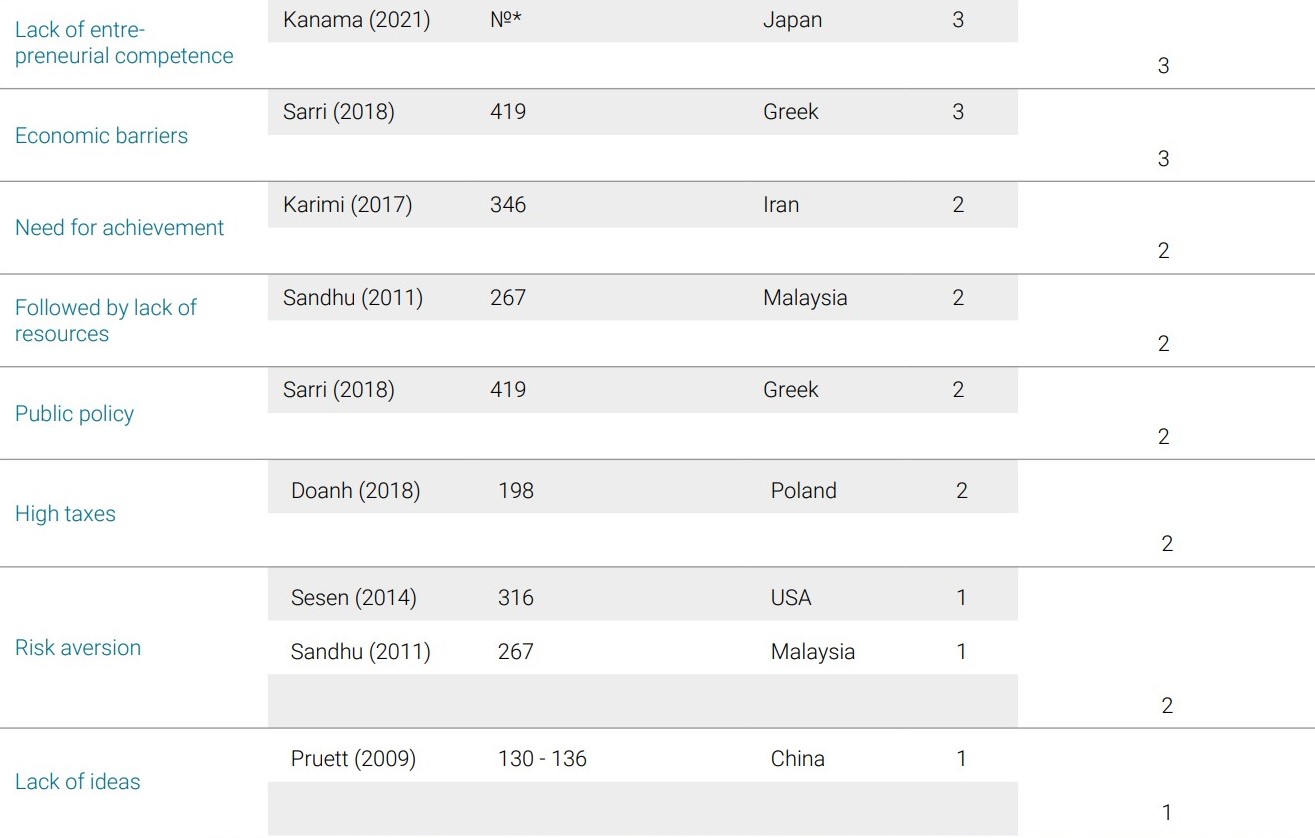

Table 2 shows a clear gradient between the individual factors from the studies. The most frequently mentioned factors in order of importance are: inhibiting entrepreneurial activities “Lack of start-up capital”, “Too much risk” and “Lack of knowledge”. The variance for these factors shows a cultural influence, as with the factor “Lack of initial capital”. While China, Spain, Po-land, and India ranked this factor as the most obstructive, the USA, Vietnam, and Belgium ranked it as the second most obstructive, and respondents in Japan ranked this factor third. Another influencing factor is the survey sample, see for example the US results, highest prioritisa-tion in 2009 & 2011 for “Excessively risky” and in 2014 for “Lack of knowledge”. This suggests either a temporal influence due to a generational change or different cultures in the surveyed samples. Another influencing factor is shown in the study by Kanama (2021) et al. with the educational level of the students surveyed. With regard to technology transfer in chemical research, it became clear that more surveys need to be conducted to get a clearer picture of the factors that promote and inhibit technology transfer from the university to start-ups.
5 Discussion
The chemical industry can be described as a key industry due to the diversity of products and possible applications. Technology transfer from universities is a key area for innovation in the chemical industry. In addition to sufficient skilled workers, new ideas and innovations are also needed to cover the demand described by Temurshoev (2004). The lack of publications in the area of innovations or technology transfer within the chemical industry shows the clarity of the need for research. The factors evaluated show overlaps in some areas such as the desire to implement one’s own ideas or the lack of start-up capital. The chemical industry, with its investment costs in equipment or research, for example, has higher capital requirements than a start-up in the service sector. At the same time, differences are shown between countries and cultures, but also between levels of education and disciplines. At the current state of the art, the literature shows a research focus on students from the fields of business administration or economics (Karabulut, 2016). Therefore, the results of the studies cannot be directly transferred to students of natural science subjects due to the different contents of the subjects.
6 Conclusion
Business start-ups are playing an increasingly important role not only in practice but also in science. Knowledge about start-ups is an elementary factor in this. The present work opens up a research gap by linking existing knowledge and the analysis for the natural sciences. For further research, the use of a comparative study of different countries is recommended, as well as the evaluation according to
various demographic factors such as gender, culture or the level of education among chemistry students. At the current state of research, there are studies on the factors that promote or inhibit spin-offs from universities. The results show that the factor “Implement my own idea” promotes spin-offs regardless of culture and generation. While the factors “Create something of my own” and “Independent” were prioritised although they have a temporal as well as cultural variation. This leads to hypothesis 1 (H1).
H1. The factors that promote spin-offs from the university are comparable across different countries.
The inhibiting factors “lack of start-up capital”, “too much risk” and “lack of knowledge” show variances due to social differences or generational differences. A difference in time and the respective level of education cannot be ruled out as influencing factors. This leads to hypothesis 2 (H2).
H2. The factors that, in the view of the respondents, inhibit a spin-off from the university depend on economic and cultural influences.
References
Abigail, J. G., Jeslin, C. J., Vijayarangan, P. B., Rakhi, Y. (2022): Chemistry Innovations and Ideas from the Classroom to the Real World: The Students’ Perspective on Becoming a Chemistry Entrepreneur. Journal of Chemical Education, 99 (4), pp. 1556-1562. https://doi.org/10.1021/acs.jchemed.1c00133
Ajzen, I. (1985): From Intentions to Actions: A Theory of Planned Behavior. In: Kuhl, J., Beck-mann, J. (eds) Action Control. pp. 11-39, SSSP Springer Series in Social Psychology. Springer, Berlin, Heidelberg. https://doi.org/10.1007/978-3-642-69746-3_2
Ajzen, I. (1991): The theory of planned behavior. Organizational Behavior and Human Decision Processes, 50 (2), pp. 179 – 211. https://doi.org/10.1016/0749-5978(91)90020-T
Aksah, H., Nawawi, A. H., Hashim, A. E., & Dewiyana, E. (2016): Assessing Score of Applicability and Importance on Functional Performance Criteria for Historical Building. Social and Behavioral Sciences, 222, pp. 65 – 74. https://doi.org/10.1016/j.sbspro.2016.05.188
Alatriste-Contreras, M.G. (2015): The relationship between the key sectors in the european union economy and the intra-European Union trade. Economic Structures, 4 (14). https://doi.org/10.1186/s40008-015-0024-5.
Arenas, Juan Jesus, and Domingo González. 2018: “Technology Transfer Models and Elements in the UniversityIndustry Collaboration” Administrative Sciences, 8 (2), https://doi.org/10.3390/admsci8020019
Blank, S. (2013): Why the Lean Start-up Changes Everything. Harvard Business Review 91. available at https://hbr.org/2013/05/why-the-lean-start-up-changes-everything, accessed 20 August 2022.
Daniela Bolzani & Federico Munari & Einar Rasmussen & Laura Toschi, 2021: “Technology transfer offices as providers of science and technology entrepreneurship education,” The Journal of Technology Transfer, Springer, 46 (2), pp. 335-365.
Chun C.L. (2007): Modeling the Technology Transfer to Taiwan from China, “International Research Journal of Finance and Economics, 7, pp. 48-66.
Chung, W. (2001): Identifying Technology Transfer in Foreign Direct Investment: Influence of Industry Conditions and Investing Firm Motives. Journal of International Business Studies 32, pp. 211–229. https://doi.org/10.1057/palgrave.jibs.8490949
Confalone, O. N. (2014): Innovation and Entrepreneurship in the Chemical Enterprise. In H. Cheng, S. Shah, M. Li Wu, Careers, Entrepreneurship, and Diversity: Challenges and Opportunities in the Global Chemistry Enterprise, pp. 163-171. Washington, DC: American Chemical Society.
Doanh, D. C. (2018): Barriers to Entrepreneurial Intention among Vietnamese and Polish Students: A Cross-Country Comparison, in: Marszałek-Kawa, J., Zakościelna, A., The Diversity of Asia in the Issues of Culture, Religion and Ethics National Economics University, Hanoi, Vietnam, pp. 153 – 176.
Dörr, N., & Müller-Prothmann, T. (2014): Innovationsmanagement: Strategien, Methoden und Werkzeuge für systematische Innovationsprozesse, in Maital, S., Seshadri ,D. V. R., Innovation Management: Strategies, methods and tolls for systematical innovation processes, München, Germany, Hanser.
Eder, P., & Sotoudeh, M. (2000): Innovation and cleaner technologies as a key to sustainable development: the case of the chemical industry. Luxembourg: The European Commission.
Engle, R.L., Dimitriadi, N., Gavidia, J.V., Schlaegel, C., Delanoe, S., Alvarado, I., He, X., Buame, S. and Wolff, B. (2010): “Entrepreneurial intent: A twelve‐country evaluation of Ajzen’s model of planned behavior”, International Journal of Entrepreneurial Behavior and Research, 16 (1), pp. 35-57. https://doi.org/10.1108/13552551011020063
Fayolle, A., Lamine, W., Mian, S. et al. (2021): Effective models of science, technology and engineering entrepreneurship education: current and future research. J Technol Transf, 46, pp. 277–287. https://doi.org/10.1007/s10961-020-09789-3
Fichter, K., & Olteanu, Y. (2022): Green Startup Monitor 2022. (B. Institut, Ed.) Retrieved from Startup Verband: available at https://startupverband.de/fileadmin/startupverband/mediaarchiv/research/green_startup_monitor/gsm_2022.pdf accessed 20 August 2022.
Franke, N., Lüthje, C. (2004): “Entrepreneurial Intentions Of Business Students — A Benchmarking Study,” International Journal of Innovation and Technology Management (IJITM), World Scientific Publishing Co. Pte. Ltd., 1 (3), pp. 269-288. https://doi.org/10.1142/S0219877004000209
Gehrke, B., & Rammer, C. (2019): Innovationsindikatoren Chemie 2019. ZEW. available at https://ftp.zew.de/pub/zew-docs/gutachten/InnoIndi_Chemie_2019.pdf accessed 22.08.2022.
Giacomin, O., Janssen, F., Pruett, M. et al. (2011): Entrepreneurial intentions, motivations and barriers: Differences among American, Asian and European students. Int Entrep Manag J, 7, pp. 219–238. https://doi.org/10.1007/s11365-010-0155-y
Graevenitz, G. v., Harhoff, D., Weber, R., & . (2010): The Effects of Entrepreneurship Education. Journal of Economic Behavior and Organization, 76 (1), pp. 90-112. https://doi.org/10.1016/j.jebo.2010.02.015
Graham, P. (2012): Startup = Growth. available at from https://www.paulgraham.com/growth accessed 28 August 2022.
Haubold, S., & Calhanoglu, B. (2022): Gründungsgeschehen Strukturanalyse. Nachrichten aus der Chemie, 70 (3), pp. 34 – 36. https://doi.org/10.1002/nadc.20224119176
Hayter, C. S. (2013): Harnessing University Entrepreneurship for Economic Growth: Factors of Success Among University Spin-offs. Economic Development Quarterly, 27 (1), pp. 18-28. https://doi.org/10.1177/0891242412471
Hewings, G. J. (1982): The empirical identification of key sectors in an economy: A regional perspective. The developing economies, 20 (2) ,pp. 173-195. https://doi.org/10.1111/j.1746-1049.1982.tb00444.x
Holgersson, Marcus & Aaboen, Lise, (2019): A literature review of intellectual property man-agement in technology transfer offices: From appropriation to utilization, Technology in Society, Elsevier, 59 (C), pp. 1-9. https://doi.org/10.1016/j.techsoc.2019.04.008
Iakovleva, T., Kolvereid, L. and Stephan, U. (2011),: “Entrepreneurial intentions in developing and developed countries”, Education + Training, 53 (5), pp. 353-370. https://doi.org/10.1108/00400911111147686
Joachim Herz Stiftung. (2021): Warum gründen deutsche Forscher:innen nicht? Zur Psychologie des Gründen.available at https://www.joachim-herz-stiftung.de/fileadmin/Redaktion/JHS_Forschen_Gruenden_2021_Web_neu.pdf accessed 30 June 2022.
Kanama, D. (2021): A comparative study of the entrepreneurial motivation of undergraduate and graduate students in Japan. Industry and Higher Education, 35 (2), pp. 102-113 . https://doi.org/10.1177/09504222209343
Kaynak, E. (1985): Transfer of Technology from Developed to Developing Countries: Some In-sights from Turkey. In A. C. Samli, (Eds.), Technology Transfer, Geographical, Economic, Culture, and Technical Dimensions, pp. 155-176. Westport, CT: Quorum Books.
Karabulut, A. T. (2016): Personality Traits on Entrepreneurial Intention. Procedia – Social and Behavioral Sciences, 229, p. 12-21. https://doi.org/10.1016/j.sbspro.2016.07.109
Karimi S, Biemans HJA, Naderi Mahdei K, Lans T, Chizari M, Mulder M. (2017): Testing the rela-tionship between personality characteristics, contextual factors and entrepreneurial intentions in a developing country. Int J Psychol, 52 (3), pp. 227-240. doi: 10.1002/ijop.12209.
Kolvereid, L. and Moen, Ø. (1997): Entrepreneurship among business graduates: does a major in entrepreneurship make a difference?, Journal of European Industrial Training, 21 (4), pp. 154-160. https://doi.org/10.1108/03090599710171404
Konrad-Adenauer-Stiftung registered association. (2015): Gründen in Deutschland. available at https://www.kas.de/c/document_library/get_file?uuid=e66bf18a2438-5a87-e54a065dbccfc3bb&groupId=252038. accessed 30 June 2022.
Landrya, R., Amaraa, N., & Rherrad, I. (2006 ): Why are some university researchers more likely to create spin-offs than others? Evidence from Canadian universities. Research Policy , 35 (10), pp. 1599-1615. https://doi.org/10.1016/j.respol.2006.09.020
Landwehr-Zloch, S., & Glaß, J. (2020): Innovationsmanagement der chemischen Industrie im digitalen Zeitalter. Berlin: Springer Berlin Heidelberg, Germany.
Malebana, M. J. (2014): Entrepreneurial Intentions and Entrepreneurial Motivation of South African Rural University Students. Journal of Economics and Behavioral Studies, 6 (9), pp. 709-726. https://doi.org/10.22610/jebs.v6i9.531.
Marzocchi, C., Kitagawa, F., & Sanchez-Barrio Luengo, M. (2019): Evolving missions and university entrepreneurship: academic spin-offs and graduate start-ups in the entrepreneurial society. The Journal of Technology Transfer, 44, pp. 167–188. https://doi.org/10.1007/s10961-017-9619-3
Opinion Leaders Network. (2022): Zu wenig Kapital nimmt Chemie-Start-ups Wind aus den Segeln. Retrieved from https://www.leadersnet.de/news/63829,zu-wenig-kapitalnimmt-chemie-start-ups-wind-aus-den-segeln.html accessed 30 July 2022.
Packham, G., Jones, P., Miller, C., Pickernell, D. and Thomas, B. (2010): “Attitudes towards entrepreneurship education: a comparative analysis”, Education + Training, 52 ( 8/9), pp. 568-586. https://doi.org/10.1108/00400911011088926
Pruett, M., Shinnar, R., Toney, B., Llopis, F., & Fox, J. (2009): Explaining entrepreneurial inten-tions of university students: a cross‐cultural study, International Journal of Entrepreneurial Behavior and Research, 15 (6), pp. 571-594 https://doi.org/10.1108/13552550910995443
Ries, E. (2011): The Lean Startup: How Today’s Entrepreneurs Use Continuous Innovation to Create Radically Successful Businesse. Crown Busines, New York, USA.
Sachse, A., & Martinez, J. G. (2016): A Brief Guide for the Chemistry Entrepreneur. In Chemistry without Borders: Careers, Research, and Entrepreneurship. ACS Symposium Series, 1219, pp. 91-107. https://doi.org/10.1021/bk-2016-1219.ch016
Sandhu, M., Sidique, S., & Riaz, S. (2011): Entrepreneurship barriers and entrepreneurial inclination among Malaysian postgraduate students. International Journal of Entrepreneurial Behav-iour and Research, 17 (4), pp. 428 – 449. https://doi.org/10.1108/13552551111139656
Sarri, A., Laspita, S., & Panopoulos, A. (2018): Drivers and barriers of entrepreneurial intentions in times of economic crisis: the gender Dimension. South-Eastern Europe Journal of Economics, 16 (2), pages 147-170.
Schlaegel, C., & Koenig, M. (2014): Determinants of entrepreneurial intent: A meta–analytic test and integration of competing models. Entrepreneurship theory and practice, 38 (2), pp. 291–332. https://doi.org/10.1111/etap.12087
Sesen, H., & Pruett, M. (2014): The Impact of Education, Economy and Culture on Entrepreneurial Motives, Barriers and Intentions: A Comparative Study of the United States and Turkey. The Journal of Entrepreneurship, 23 (2), pp. 231–261. https://doi.org/10.1177/0971355714535309
Shapero, A., The Entrepreneurial Event, In: C. A. Kent Ed., The environment for entrepreneur-ship, M.A.: Lexington Books, Toronto, 1984, pp. 21-40.
Society of German Chemists. (2020): Statistik der Chemiestudiengänge. Frankfurt am Main: Nachrichten aus der Chemie. Retrieved from https://www.gdch.d/fileadmin/blaetterkatalog/index.php?catalog=statistik_2020 accessed 30 August 2022.
Statistisches Bundesamt (Destatis). (2022): Bildung und Kultur – Personal an Hochschulen. Berlin: Statistisches Bundesamt. Retrieved from https://www.destatis.de/DE/Themen/Gesellschaft-Umwelt/Bildung-ForschungKultur/Hochschulen/Publikationen/_publikationen-innenhochschulen-personal.html, accessed 30 August 2022.
Sternberg, R., Gorynia-Pfeffer, N., Stolz, L., Baharian, A., Schauer, J., Chlosta, S., & Wallisch, M. (2022): Global Entrepreneurship Monitor – Unternehmensgründungen im weltweiten Vergleich. Eschborn: Babson. available at https://www.gemconsortium.org/file/open?fileId=50944 accessed 30 November 2022
Temurshoev, U. (2004): Key Sectors in the Kyrgyzstan Economy. Discussion Paper No. 2004-135, Charles University.
Thiel, P., & Masters, B. (2014): Zero to One. Crown Business. Retrieved from www.crownpublishing.com
Wierciński, S. (2016): Antecedents and Dynamism of Decision-Making Logic in Global-Minded Start-Ups. Kozminski University. available at http://bi.gazeta.pl/
im/5/24786/m24786545,RAPORT.pdf accessed 01 November 2022
Wolf, V., Dobrucka, R., Przekop, R., & Haubold, S. (2021): Innovation strategies in the context of the paradigm of the five dimensions of innovation strategy. Scientific Journal of Logistics, 17 (2), pp. 205-211.
Wood, M. S. (2011): A process model of academic entrepreneurship. Business Horizons, 54 (2), pp. 153–161. https://doi.org/10.1016/j.bushor.2010.11.004